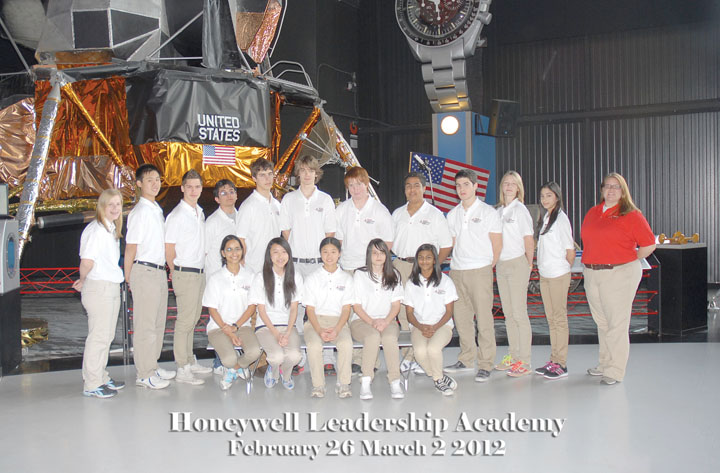 They are still young, and only time will tell, but David Siems and Nathan Hui may be part of a new generation of skilled engineers, scientists and leaders.
They are still young, and only time will tell, but David Siems and Nathan Hui may be part of a new generation of skilled engineers, scientists and leaders.
One thing is certain, however. Both young men are exceptional students from our side of Mesa.
Recently, these 10th-graders returned from the Honeywell Leadership Challenge Academy (HLCA), at the U.S. Space and Rocket Center, in Huntsville, Ala. They had earned scholarships for the weeklong Science, Technology, Engineering, Math (STEM) program. Typically, students were engaged in projects from 6 a.m. until 11:30 p.m.
Both high school students returned to Arizona filled to the brim with scientific hands-on experiences and a plethora of friendships with like-minded young scientists.
“The most exciting thing for me was the centrifuge,” Nathan recalled. “You only get to ride it when you are an astronaut in training.” Inside this machine, students were exposed to 3G forces.
“We were asked to follow certain commands,” Nathan reported. “Like to give a high five or push off against the walls.” That was not at all easy under that kind of pressure. “But F18 fighter pilots experience up to 9G force, and they still have to perform,” Nathan said.
Nathan is a Mesa Academy alumnus, from the Crismon/Baseline neighborhood, and currently is enrolled in the Westwood IB Program. He has a solid track record in the robotics world. Like all HLCA participants, he had to submit qualifying essays on his scientific ambitions and academic successes.
Nathan thought the quality of simulations was amazing. During flight simulator exercises, his team was given numerous tasks of flying and landing maneuvers for various aircraft, reenacting dog fights (air battles), and following through on counter-terrorist missions, while escorting Air Force One to safety.
Although Nathan had to catch up on quizzes for school, he did not regret his high-caliber excursion one bit. “I got to meet so many other people from other cultures,” he commented. “The administrators told us that 30 countries were represented.”
“This exposure program really set the bar for me,” he summarized. “I met so many professionals, from the field, and got many questions answered. Working with them was like, ‘Wow, I want to be like him.’” Nathan might even have been swayed from his interest in medicine into civil engineering.
David, a Skyline High School student from the Boulder Mountain neighborhood, whizzed through the same HCLA training modules one week later. He debriefed his parents on the scientific enrichment, one photo at a time.
“Here, we had to build a customized rocket from three different kits,” he recalled. Rocket parts were mixed and matched according to specifications. Then, the prototype was tested in the wind tunnel. With the center of gravity at issue, the question was, “How can you make the rocket fly straight?”
“Our rocket was too heavy, it turned out,” David stated. “So, our model burned off on the ground during launch.” Much like in the real world, learning by doing required accepting systemic failure and readjusting the approach.
“In the science lab, we extracted DNA from fruit and cubes of meat,” he reported. “We mashed up the samples, and added different kinds of soap, ranging from baby shampoo to dishwashing detergent.” Not many results turned out in this segment.
But David already knew success rewards those like him, who don’t give up. In last year’s Eagle Scout project, David led a team to complete a large-scale beautification project for his neighborhood Trinity Christian Church.
These credentials, plus extensive robotics experience and expertise with a soldering iron, were a bonus for David in the STEM program. An outstanding student, David is a member of the National Honor Society, and he participates in marching band.
As such, David was thrilled about being exposed to athink tank of like-minded, ambitious, international age cohorts. “All of these kids were on the honor roll, ROTC, Boy Scouts, and had impressive résumés,” David said.
Like Nathan, David blazed through the projects with passion. The centrifuge impressed him somewhat, too. But virtually piloting an F18 fighter jet was even better.
“They taught us to take off and land, to shoot and drop missiles,” he said. “I was soon doing the air-to-air stuff.” Whatever the scenario, the pilots had to follow the orders in their scripts.
“I had already landed safely,” David said, “but still carried a few rounds of ammunition. So, I had to go up again, to spend it all in the air, before I could refuel. But the second time around, I unfortunately crashed.”
David caught on quickly to the team building exercises, as he previously had conducted the Eagle Scout project. In one drill, students practically created an electrical circuit between two ends of a breadboard by holding hands.
Teamwork efficiency was tested through an assembly line module. “In the first round, we created the product in two minutes, with 200 wasted items,” David reported. “In the second run, we finished the task in 12 seconds, with only five wasted items.”
“The biggest challenge for me was a rock wall exercise,” he conceded, “because I am not used to heights.” The objective was to reach the top as a team of two, tethered together without tearing off the connecting ropes.
Best of all, the STEM program fit in well with his curriculum, down to the French. David was able to carry on a full conversation in this foreign language. And with a great sense of humor, he owned up to Karaoke night, too. “That could go as a substitute for band practice,” he smiled.
Texting his mom, Cindy, toward the end of the program, David informed her, “I learned a few leadership skills.” And, he added, “I made memories that I will never forget.”

